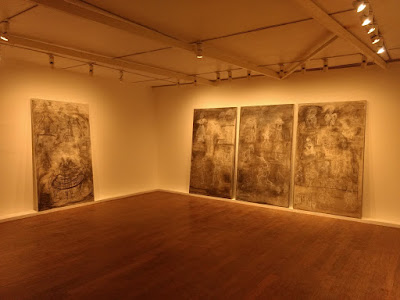Women at War
Ornaments and items of armour in Shakuntala Kulkarni’s works present a measured tension between tenderness and aggression, claims Anuj Daga.
Ornamenting the self is an act of de-familiarization. It rearticulates the surface of the body into new outlines. At Chemould Prescott Road, Mumbai, in Julus and Other Stories, Shakuntala Kulkarni mobilizes these aspects of the ornament while also exploring its other characteristics like protection and decoration. The show, from the 13th of March to the 7th of April, comprises chalk drawings, photographs, cane armour and ornaments along with a video within which the artist inhabits these idea-forms.
The viewer is greeted with an array of cane armour objects and adornments presented like disembodied parts. Masks, cages, shields, headgears, bands, earrings, laces – all woven in cane in variegated shapes and forms – suggest different ways of covering and securing the body.
The use of cane domesticates adornment as well as armoury. Their exchange or utilitarian values are removed, making them amenable for the everyday. The work quietly blurs questions of sentimentality and security within each other. It brings us to consider the politics of adornment and armoury in unintended but clever ways. In several cultures, for example, strategic parts of clothing are embroidered so as to ward off the evil eye. If such an analogy is extended to ornaments and their location, decoration and their bodily fixation, it creates a space of distraction through which a politics of defence may be softly mobilized. On the other hand, locating cane armour within several delicately woven jewelleries at once mellows the aggression contained in the objects of war. The measured tension between tenderness and aggression begins to mediate a new understanding of power.
The wall-projected video animates the objects and drawings and brings them to life. The artist’s enactment – assuming new postures within the sinuous cane frameworks – gives rise to the experience of the female body adorned as well as trapped within the creations. Perhaps, it is here that a larger commentary on the subject of gender emerges in the artist’s work. Within which kinds of apparatuses is the narrative and social status of women enmeshed today? How does one challenge these frameworks and what kind of orientations can these questions have towards action and re-identification? Kulkarni’s chalk drawings offer studies presenting histories of ornament usage; they also trace the transformation of the ornament into a weapon on the path of claiming the powerful, performative self.





No comments:
Post a Comment